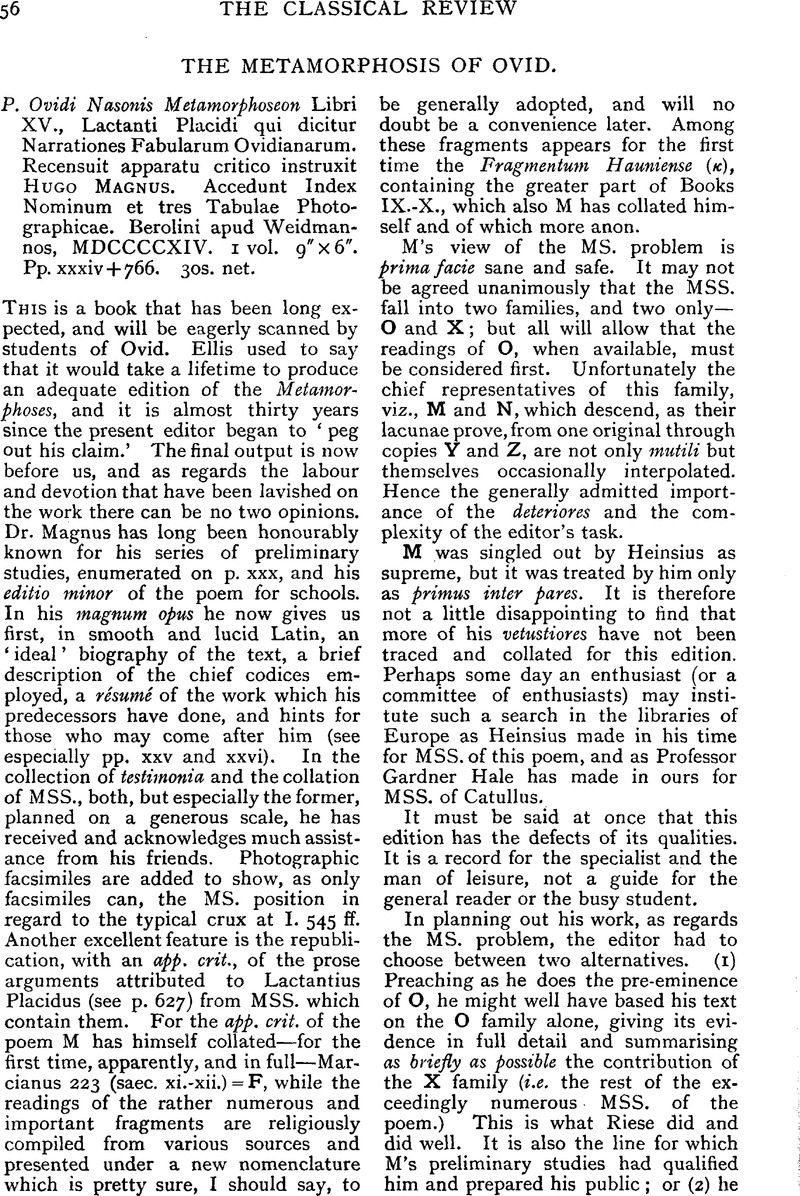No CrossRef data available.
Article contents
The Metamorphosis of Ovid - P. Ovidi Nasonis Metamorphoseon Libri XV., Lactanti Placidi qui dicitur Narrationes Fabularum Ovidianarum. Recensuit apparatu critico instruxit Hugo Magnus. Accedunt Index Nominum et tres Tabulae Photographicae. Berolini apud Weidmannos, MDCCCCXIV. I vol. 9″ × 6″. Pp. xxxiv + 766. 30s. net.
Review products
Published online by Cambridge University Press: 27 October 2009
Abstract

- Type
- Reviews
- Information
- Copyright
- Copyright © The Classical Association 1915
References
page 57 note 1 See the list enumerated in Loers, Praefatio.
page 57 note 2 See Chatelain, Paléographie des Classiques Latins, Planche xcv.
page 57 note 3 Cf. Anth. Pal. V. 132 … ![]() ; Ovid, de Arte Am. I. 53, III. 191, etc.; and for Andromedā, Lachm. Lucretius, p. 405. At Met. XIII. 523 the MSS. waver between ‘dofabere’ and ‘dowabere.’
; Ovid, de Arte Am. I. 53, III. 191, etc.; and for Andromedā, Lachm. Lucretius, p. 405. At Met. XIII. 523 the MSS. waver between ‘dofabere’ and ‘dowabere.’
page 58 note 1 Anecdota Oxoniensia, Classical Series, i. 5 (1885). There is a facsimile in Chatelain, op. cit., Planche 97. 1.
page 58 note 2 The Beneventan Script, p. 354.
page 58 note 3 For this use of auctor cf. Tristia, IV. 4. 26 and 34; Met. VI. 172.
page 58 note 4 Two other misstatements in M's note on this line need correction. N has qua (not quo), and M's reading is quite uncertain, ‘qu/02 (a eras) M,’ says M. Signor Rostagno examined the manuscript with me, and agreed that the letter erased is quite as likely to have been an æ diphthong as an a. M makes such play with his recollation of M and N that one might reasonably have expected him to quote their readings at any rate correctly throughout.
page 59 note 1 So also in the text of the poem at X. 215. There again M overlooks the cedillas.
page 59 note 2 The corresponding line of the poem (IX. 779) is corrupt. Punior is not Ovidian, and Plan, seems here, as elsewhere, to be translating a gloss, ![]() . The variants suggest something like—Quod uidet haec lucem, quod non ego conscia plector.
. The variants suggest something like—Quod uidet haec lucem, quod non ego conscia plector.
page 59 note 3 Paris. 8001 was identified by Loers (praef. ad init.) with the Codex Berneggerianus Heinsii. Yet (e.g.) at I. 530 M gives us the note ‘deo I flamma est cc Bernegg. et Par. 8001’—![]() So also at V. 343. There, however (at the dictates of prudence), the number 8001 is dropped; but see Lemaire. Similarly at I. 69 φ is the Liége fragment. Delete from the note either φ or ‘frg. Leodinense.’
So also at V. 343. There, however (at the dictates of prudence), the number 8001 is dropped; but see Lemaire. Similarly at I. 69 φ is the Liége fragment. Delete from the note either φ or ‘frg. Leodinense.’
page 59 note 4 See Madvig, Aduersaria Critica, ii. 83 (the reference is given in the not. Crit.).
page 59 note 5 Merkel is cited as in favour of the reading; but Merkel (p. xxxii) begins by describing the construction thus: ‘Manifestos, quantum puto, barbarismus et sine exemplo.’
page 59 note 6 There are excerpts and collations of thirtyfour MSS., mostly ‘notae inferioris.’


